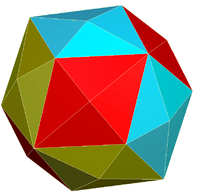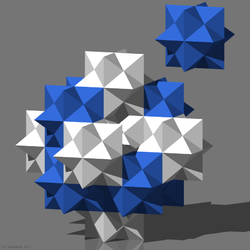First stellation of rhombic dodecahedron


In geometry, the first stellation of the rhombic dodecahedron is a stellation of the rhombic dodecahedron. This polyhedron is sometimes called Escher's solid; it appears in M. C. Escher's works Waterfall and in a study for Stars (although Stars itself features a different shape, the compound of three octahedra).
Geometry
It has 48 faces, all triangles. It has 26 vertices in total: 6 with degree 8, 8 with degree 6, and 12 with degree 4. It has 72 edges in total, giving an Euler characteristic of 26+48-72 = +2. Its vertices are identical to those of the cuboctahedron. It can be constructed by taking a square pyramid of base length 2 and height 1, with the base centered at the origin and the apex on the Z-axis, and then rotating it so that the apex lies on each of the 6 half-axes in turn. The union of the six square pyramids gives the stellated rhombic dodecahedron.
Space-filling
It can tessellate space in the stellated rhombic dodecahedral honeycomb. Six stellated rhombic dodecahedra meet at each vertex. This honeycomb is cell-transitive, edge-transitive and vertex-transitive.
See also
External links
- George Hart, Stellations
